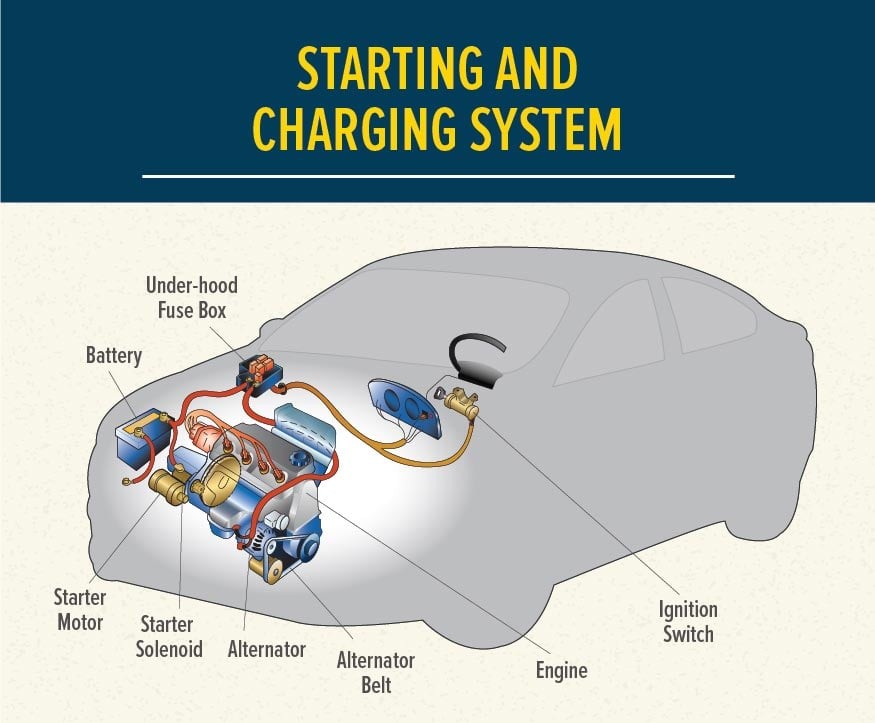Your car battery is essential for getting your vehicle started and powering its electrical components. But what keeps this vital component charged so you’re not constantly stranded with a dead battery? The answer lies in a crucial part of your car’s engine: the alternator.
This article will delve into the role of the alternator and other components within your car’s charging system, explaining how your battery stays powered while driving and addressing common questions about car battery charging.
The Alternator: Your Car Battery’s Personal Generator
The primary car part responsible for charging your battery is the alternator. Think of the alternator as a mini power plant for your car. Once your engine is running, the alternator takes over the job of providing electrical power and crucially, recharging the battery.
Located at the front of the engine and driven by a belt connected to the engine’s crankshaft (often called the serpentine belt or alternator belt), the alternator converts mechanical energy from the engine’s rotation into electrical energy. This electricity then serves two main purposes:
- Powering Electrical Systems: The alternator supplies the necessary electricity to run all of your car’s electrical systems while the engine is running. This includes your headlights, windshield wipers, radio, air conditioning, power windows, and the car’s computer systems.
- Recharging the Battery: Simultaneously, the alternator sends a current back to the car battery to replenish the energy used during starting and to compensate for the continuous drain from electrical accessories.
 Vehicle Starting and Charging System
Vehicle Starting and Charging System
The Car Battery: More Than Just Starting Power
While the alternator is charging the battery, it’s important to remember the battery’s primary functions. The car battery’s initial role is to provide a high burst of energy to start the engine. This is achieved through a chemical reaction within the battery.
Car batteries are typically lead-acid batteries, available in two main types:
- Flooded Batteries (Wet Cell): These are the traditional type, containing liquid electrolyte. They may require occasional maintenance like topping off fluid levels.
- AGM Batteries (Absorbed Glass Mat): These are sealed and more advanced, with the electrolyte absorbed in glass mats. They are often used in newer vehicles, especially those with start-stop technology, as they handle deeper discharges and recharges better.
Both types rely on a chemical reaction between lead plates and an electrolyte solution (sulfuric acid and water) to generate electricity. When you turn the ignition, this chemical reaction is triggered.
The starting system itself involves a few key components working in sequence:
- Ignition Switch: When you turn your key or press the start button, you activate the ignition switch.
- Starter Relay (Solenoid): The ignition switch sends a small electrical signal to the starter relay. This relay then closes a circuit.
- Starter Motor: The closed circuit allows the battery to send a high current to the starter motor. The starter motor then engages with the engine’s flywheel, cranking the engine until it starts.
Once the engine is running, the alternator takes over the electrical supply and battery charging duties.
The Voltage Regulator: Maintaining Optimal Charge
An important component working in conjunction with the alternator is the voltage regulator. This part ensures that the battery receives the correct amount of charge and that the electrical system operates at the proper voltage.
The voltage regulator prevents:
- Overcharging: Too much charge can damage the battery, shortening its lifespan and potentially causing it to overheat or leak.
- Undercharging: Insufficient charge will leave the battery depleted, potentially leading to starting problems and premature battery failure.
The voltage regulator constantly monitors the battery’s voltage and adjusts the alternator’s output to maintain a steady charging rate, optimizing battery health and performance.
Factors Affecting Battery Charging and Battery Life
Several factors can impact how effectively your car battery charges and its overall lifespan:
- Driving Habits: Frequent short trips, especially with heavy electrical accessory use (like headlights and AC), may not give the alternator enough time to fully recharge the battery.
- Deep Discharge: Leaving lights or accessories on when the engine is off can deeply discharge the battery. Repeated deep discharges can significantly shorten battery life.
- Climate: Extreme temperatures, both hot and cold, can negatively affect battery performance and lifespan. Cold temperatures reduce battery capacity and cranking power, while heat can accelerate battery degradation.
- Battery Type: AGM batteries generally handle deep discharges and extreme temperatures better than standard flooded batteries.
- Battery Age: Car batteries have a limited lifespan, typically ranging from 3 to 5 years. As batteries age, their capacity decreases, and they become less efficient at holding a charge.
Maintaining Your Car Battery for Longevity
To ensure your car battery functions optimally and lasts as long as possible, consider these maintenance tips:
- Regular Checks: Periodically inspect your battery terminals for corrosion. Clean any buildup with a wire brush and baking soda solution.
- Limit Deep Discharges: Avoid leaving lights or accessories on for extended periods when the engine is off.
- Professional Battery Testing: Have your battery tested regularly, especially as it gets older, to assess its health and charging capability. Most auto service centers offer free battery checks.
- Ensure Proper Charging System Function: If you suspect charging issues, have your alternator and voltage regulator checked by a qualified mechanic.
Conclusion
So, to answer the primary question: the alternator is the car part that charges the battery. This vital component works tirelessly while your engine is running to keep your battery replenished and power your vehicle’s electrical systems. Understanding the role of the alternator and practicing basic battery maintenance can help you avoid unexpected battery failures and keep your car running smoothly.